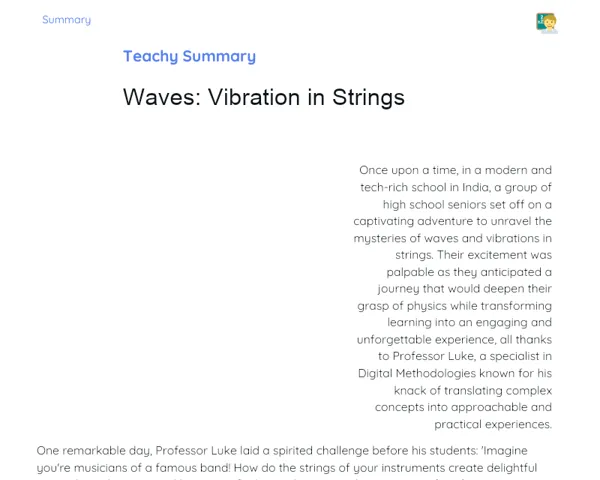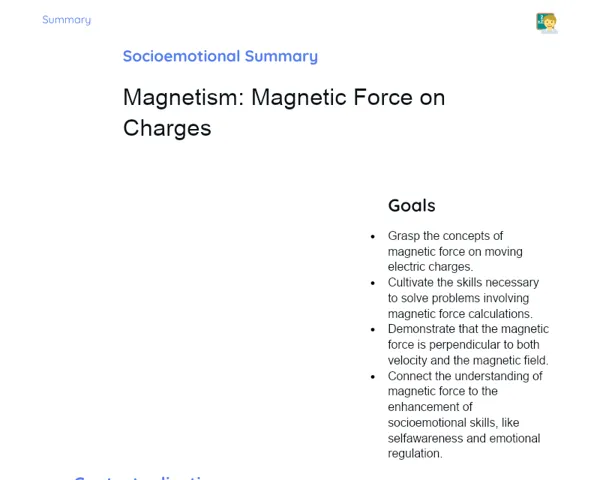Objectives
1. 🌊 Gain a thorough understanding of the wave equation that explains wave motion over time, using the basics of sinusoidal functions.
2. 🔍 Learn to identify and adjust key parameters such as amplitude, frequency, and speed which determine how waves behave in different media and situations.
3. 🚀 Use this knowledge to tackle both practical and theoretical problems related to various wave properties.
Contextualization
Did you know that waves are not only a captivating phenomenon in nature but also form the backbone of many technologies we use every day? For instance, technologies like Wi-Fi and Bluetooth work on the principles of electromagnetic wave propagation. By understanding how waves operate and how we can express their behaviour mathematically, we not only get a clearer insight into the world around us but also find ways to innovate and enhance these everyday technologies.
Important Topics
Sinusoidal Functions
Sinusoidal functions are fundamental in mathematically describing waves as they effectively capture the oscillatory behaviour seen in many natural occurrences. A sinusoidal wave represents a regular, repeating oscillation – think of it as similar to the vibration of a guitar string or the sound produced by a tuning fork.
-
The standard form of a sinusoidal wave is given by y = A sin(ωt + φ), where A denotes the amplitude, ω is the angular frequency, t is time, and φ is the initial phase.
-
The amplitude, A, dictates the maximum height of the wave and is closely linked to the energy the wave carries.
-
Angular frequency ω indicates how fast the wave oscillates and is related to the frequency f by the formula ω = 2πf.
Wave Equation
The wave equation is a partial differential equation that models the way a wave travels through any given medium like air or water. This equation is key to understanding how disturbances at one point travel across space and time.
-
The one-dimensional wave equation is generally expressed as ∂²y/∂x² = (1/v²) ∂²y/∂t², where y represents the wave function, x is the position within the medium, t is time, and v is the wave speed.
-
This shows that the wave's acceleration is linked to the curvature of its amplitude, implying that waves travel faster in media that are stiffer or have higher tension (i.e., with a higher value of v).
-
Depending on the scenario, the wave equation can be modified to suit one-dimensional, two-dimensional, or even three-dimensional waves, based on the medium's structure and wave geometry.
Propagation Speed
The speed at which a wave propagates through a medium is a vital property that depends on characteristics like density, elasticity, and tension of that medium rather than on the wave’s amplitude or frequency. Knowing this speed is crucial for predicting how the wave will behave in different conditions.
-
The wave speed v in a medium is given by the relation v = λf, where λ is the wavelength and f is the frequency of the wave.
-
In uniform (isotropic) media, the speed of propagation remains the same in all directions. In contrast, in non-uniform (anisotropic) media, it might vary with direction.
-
Classic examples include the speed of sound and the speed of light, both of which depend on the medium through which these waves travel.
Key Terms
-
Wave: A disturbance moving through a medium that transfers energy from one point to another without actually moving matter.
-
Amplitude: The peak value of the wave from its rest position, indicating the wave’s maximum displacement.
-
Frequency: The number of wave cycles passing a point each second, measured in Hertz (Hz).
-
Wave Speed: The rate at which the wave disturbance moves through a medium, typically expressed in meters per second.
For Reflection
-
How does the amplitude of a wave affect the energy it transports and its impact on a receiver?
-
Why is the speed of light constant across all reference frames as per Einstein's theory of relativity?
-
How can an understanding of waves help us enhance technologies such as wireless communications and medical diagnostics?
Important Conclusions
-
In this lesson, we delved into the properties of waves and saw how they can be expressed using sinusoidal equations. It became clear that waves are not only crucial in natural phenomena but are also integral to modern conveniences like Wi-Fi and Bluetooth.
-
We examined how factors like amplitude, frequency, and speed influence wave behaviour and how the wave equation can be used to forecast and understand the movement of waves in different media.
-
This knowledge is indispensable not just in academic physics but also for real-world applications in areas such as acoustics, communication, and even healthcare, where understanding waves is of great importance.
To Exercise Knowledge
To reinforce your understanding, try these activities: 1. Build a simple wave model using a spring and observe how adjusting the tension alters the wave speed. 2. Explore a wave simulation app to see how waves behave in different media. 3. Take on the role of a 'Mathematical Surfer': Simulate waves in a virtual surfing setup by tweaking parameters like wave height and frequency to create the perfect surfing wave.
Challenge
Challenge yourself as a 'Wave Composer': Using your knowledge of sinusoidal functions, create a piece of 'wave music' by representing different wave types (sound, light, etc.) through simple musical instruments or software. Share your creation with visuals and audio in class!
Study Tips
-
Regularly revisit the wave equations and try applying them to everyday situations, like analysing sound waves at a local concert or water waves at a pond.
-
Experiment with online wave simulation tools to better visualise and understand wave behaviour under various conditions.
-
Discuss with your friends or family how waves are integral to everyday technology, such as in mobile phones and radios, to witness practical physics in action.



